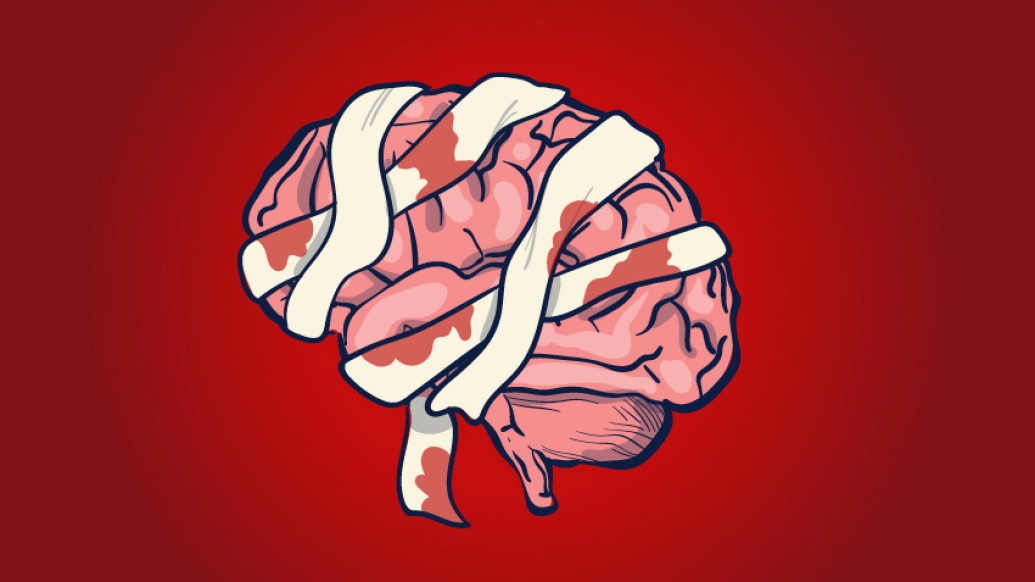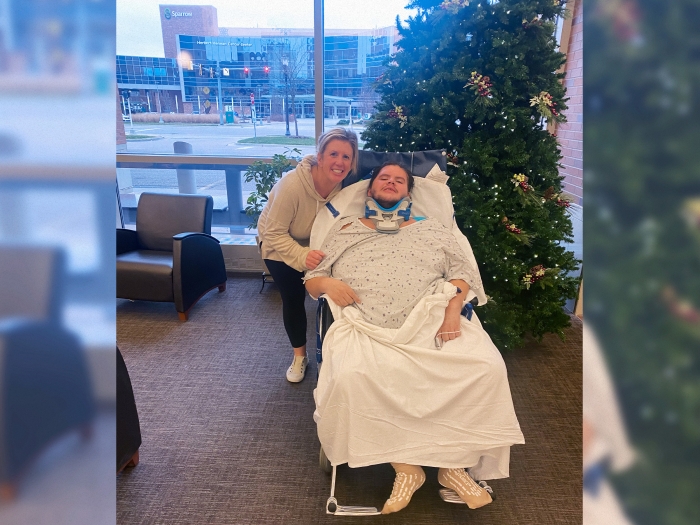From the way it is classified to long-term care options, experts say major changes are needed to address the global issue.
11:15 AM
Author |

Every year, nearly 5 million Americans are evaluated for traumatic brain injury in emergency departments across the country.
These injuries can happen in many different ways – from car crashes and military conflict to falls and everyday activities – and they're diagnosed in around 2% of all United States emergency department visits.
Awareness of the magnitude of TBIs has increased over the last several decades, particularly in sports and the military. But a group of experts from across the nation say the country's current system of care is often failing to meet the needs of the individuals, families and communities affected by traumatic brain injury.
"We as physicians are frustrated that there are significant limitations to what we can do for our patients for an injury that has real-life, debilitating consequences," said Frederick Korley, M.D., Ph.D., associate professor of emergency medicine at Michigan Medicine. "There are many important, structural changes that need to be made to provide better care for patients who often go through a prolonged recovery process."
Korley is part of a select team of researchers who recently authored a report analyzing the health care system's response to TBI for the National Academies of Sciences, Engineering, and Medicine. The study, funded by the U.S. Department of Defense, found that the lack of a comprehensive framework for classification, care and research poses significant burdens for everyone involved – leading to needless death, squandered human potential and soaring costs. Their report contains numerous recommendations for improving TBI care and research.
TBI classification
When those near-5 million Americans arrive at the ER each year to be evaluated for brain injuries, they are placed into one of three categories: mild, moderate or severe.
It seems simple. The driver who is comatose after a devastating car crash would be considered severe, while the student who has a headache after slipping on black ice could be seen as mild. To Korley, who sees many of these so-called "mild" cases in the emergency department, the classification is inadequate – and, in some cases, insulting to patients.
SEE ALSO: Research into Innovative Treatment Ideas for Traumatic Brain Injury
"Some people who are considered 'mild' can't go to work; they have horrible headaches and memory problems that can result in losing a job or dropping out of school," he said. "Conversely, there are some people classified as 'severe' but actually do way better than we expect. Those cases don't all result in death or devastating disability."
This lack of distinction, the report notes, leads to suboptimal care across the spectrum of TBI and can include withdrawing life-sustaining treatment for patients who could have improved.
Instead of the shorthand, the researchers recommend using the full Glasgow Coma Scale score, a system that grades the severity of TBI on a scale from three to 15, in addition to results from brain CT scans and blood tests to classify patients. This approach provides a more accurate, nuanced assessment of the injury, Korley said.
"Let's say we have two cases of 'mild' TBI," he said. "One is a patient who has a concussion and experienced light sensitivity but felt fine not long after, and the other is someone who is awake but so out of it that they ask the same question repeatedly. The first would be a GCS 15, and the second would be a GCS 13. Calling both patients 'mild' is an oversimplification. Saying one is a GCS 15 TBI and the other is a GCS 13 TBI is more descriptive and will inform additional treatment plans."
Emergency physicians also rely heavily on neuroimaging through CT scans to find evidence of brain bleeding and determine if surgery is necessary. Recently, they have started using blood tests to justify neuroimaging and reduce the number of unnecessary scans. These blood tests can also help physicians better characterize the severity of the injury. The research team advocates for a classification system utilizing all three methods.
"This full range of analysis will make for a more accurate and sophisticated description of the injury that will inform individualized treatment and aid in predicting long-term outcomes more accurately," Korley said.
Delivery and continuity of care for patients with TBI
To many, the "traumatic brain injury" suggests an isolated event. A dramatic scene of a crash victim or wounded soldier receiving lifesaving medical intervention, possibly being cured.
This is a misleading view, Korley says. Think of TBI like COVID-19.
Many people who are hospitalized with the virus do not die, which could be seen as a 'recovery.' But almost half of those people experience significant functional decline after they're discharged. And scores of people with 'mild infection' end up with lingering symptoms of long COVID that can impact their lives.
We want to drive more progress as we create a blueprint for clinicians, researchers and stakeholders who are committed to solving this problem.Frederick Korley, M.D., Ph.D.
Like COVID-19, many of those 'recovering' from TBI experience a chronic phase of the injury. However, only 13 to 25% of patients with moderate-to-severe traumatic brain injury end up receiving interdisciplinary inpatient rehabilitation.
"There is the notion that once you leave the hospital after TBI, that's as good as it gets, but it's only the beginning of the battle," Korley said. "The acute phase is when you try to limit secondary brain injury. The chronic phase is a much longer healing process."
For an injury that researchers say is vastly undercounted, they note the United States has no mechanism for long-term TBI care. And for what is available, many survivors do not have, or cannot afford, access.
"Many people actually max out their benefits at that point [of inpatient rehab]," said one TBI patient quoted in the report. "Then when they are home, they have problems and don't have the insurance funds to help with those. To me, it's just criminal that so many victims of TBI are just forced by insurance companies into bed rest, which is just killing their chances of a good recovery."
SEE ALSO: Understanding Quality of Life for Caregivers of Persons with Traumatic Brain Injury
Korley and the committee recommend creating a national framework for TBI care. They say it should build on the successes of regional trauma systems by establishing local and regional integrated care delivery systems across acute, rehabilitation and recovery phases of the injury. They also want health insurers, Medicare and Medicaid services to offer coverage for TBI care that aligns with clinical guidelines, ensuring equity in access and affordability.
"[Taking these steps] would require a level of continuity and acceptance of responsibility that American health care does not often achieve for chronic illnesses," researchers wrote.
Research and innovation
To date, there is no FDA-approved therapy that can treat damage from traumatic brain injury on its own. Several promising therapies have failed to promote recovery in large clinical trials.
Meanwhile, the committee says research on TBI is feeble compared to other important conditions, such as cancer or heart disease. They called for government organizations – the National Institutes of Health, the Department of Defense – and private sector funders to commit to a much larger investment in basic and clinical research to improve the health and well-being of TBI survivors.
Working with the Department of Defense, the Weil Institute for Critical Care Research and Innovation at University of Michigan hosts an annual Massey TBI Grand Challenge, which provides funding for early-stage, innovative and high-risk research to develop the next generation of diagnostics, devices and therapeutics for severe TBI. Researchers make 'Shark Tank'-style pitches to a panel of clinicians and commercialization experts for innovative ways to advance early care. Over six years, 39 teams have been funded with over $4 million awarded.
"This program provides a unique and vital mechanism to bring together diverse expertise from across U-M to propose and develop the almost-science fiction solutions and technologies that will be required to significantly impact the care of victims of TBI," said Kevin Ward, M.D., executive director of the Weil Institute and professor of emergency medicine and biomedical engineering at Michigan Medicine. "The program encourages collaboration across the medical, engineering, basic and computational sciences, and it is really helping us shorten the research and development cycle through strategic de-risking."
Without an entity taking charge to establish clear goals and conduct oversight, experts say, progress is unlikely.
"We want to drive more progress as we create a blueprint for clinicians, researchers and stakeholders who are committed to solving this problem," Korley said. "We are hoping that governmental leaders will pay attention and help redirect funding priorities. A lot of the recommendations we are proposing will take significant funding to implement. This is how our nation will start showing up for survivors of traumatic brain injury, their caregivers and communities."
This activity was supported by Contract No.W81XWH20C0126 between the National Academy of Sciences and the United States Army Medical Research and Development Command of the Department of Defense. Any opinions, findings, conclusions, or recommendations expressed in this publication are those of the authors and do not necessarily reflect the views of any organization or agency that provided support for the project. The views, opinions and/or findings contained in this report are those of the author(s) and do not necessarily reflect the views of the United States Army Medical Research and Development Command (USAMRDC).
Paper cited: "Traumatic brain injury: A roadmap for accelerating progress," National Academies of Sciences, Engineering, and Medicine. DOI: 10.17226/25394
Like Podcasts? Add the Michigan Medicine News Break on iTunes, Google Podcasts or anywhere you listen to podcasts.

Explore a variety of healthcare news & stories by visiting the Health Lab home page for more articles.

Department of Communication at Michigan Medicine
Want top health & research news weekly? Sign up for Health Lab’s newsletters today!





